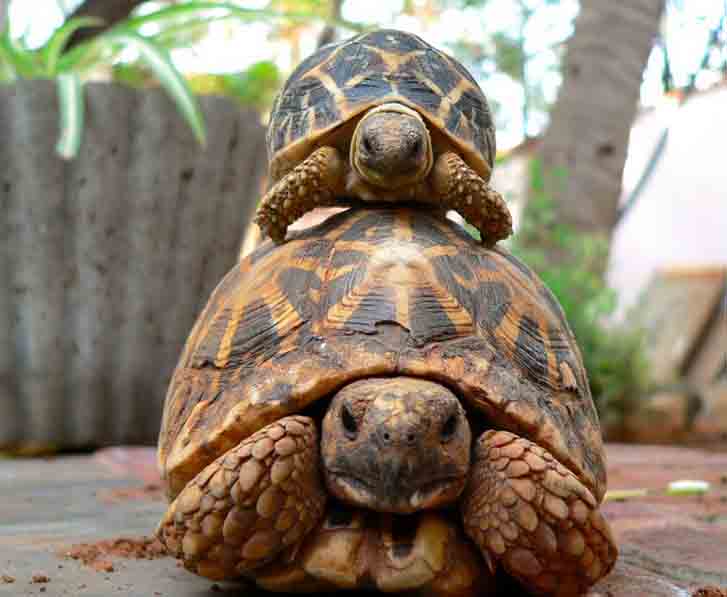

Turtles, Tortoises, and Terrapins are reptiles of the Order Testudines (all living turtles belong to the crown group Chelonia), most of whose body is shielded by a special bony or cartilagenous shell developed from their ribs. The Order Testudines includes both extant (living) and extinct species, the earliest known turtles being from around 215 million years ago, making turtles one of the oldest reptile groups, and a much more ancient group than lizards and snakes. About 300 species are alive today; some are highly endangered.
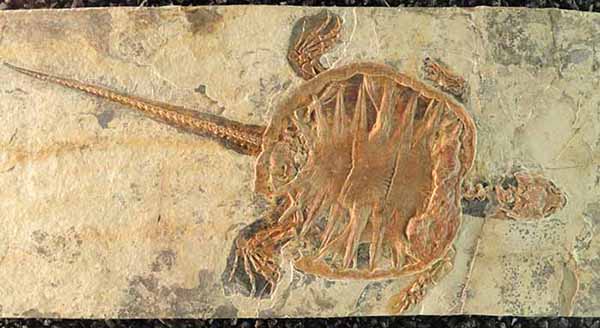
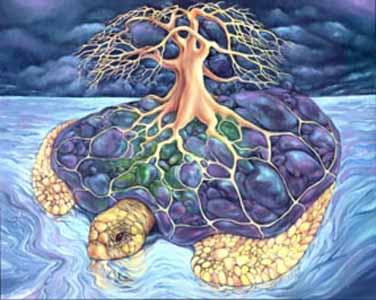
Turtle Island is the name of North America, according to some indigenous groups. The Lenape story of the "Great Turtle" was first recorded between 1678 and 1680 by Jasper Danckaerts. The story is shared by other Northeastern Woodlands tribes, notably the Iroquois. The term originates mainly from oral tradition, in the tale of the westward travel of the Anishinabe tribe on the land known as Turtle Island, as recorded also in the birch bark scrolls.
According to Iroquois oral history, Sky Woman fell down to the earth when it was covered with water. Various animals tried to swim to the bottom of the ocean to bring back dirt to create land. Muskrat succeeded in gathering dirt, which was placed on the back of a turtle, which grew into the land known today as North America. In the Seneca language, the mythical turtle is called Hah-nu-nah, while the name for an everyday turtle is ha-no-wa.
The name Turtle Island is used today by many Native tribes, Native rights activists, and environmental activists, especially since the 1970s when the term came into wider usage. In a later essay, published in At Home on the Earth, Gary Snyder claimed this title as a term referring to North America that synthesizes both indigenous and colonizer cultures by translating the indigenous name into the colonizer's languages (the Spanish "Isla Tortuga" being proposed as a name as well). Snyder argues that understanding North America under the name of Turtle Island will help shift conceptions of the continent.
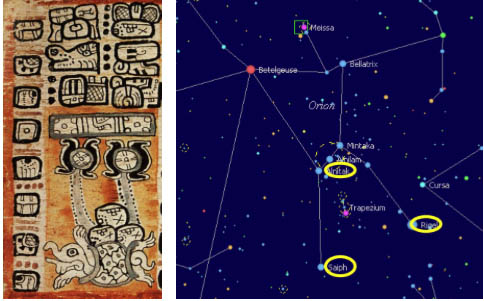
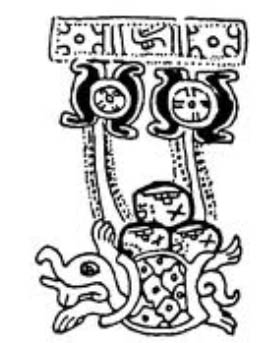
Heathstone constellation, positioned on the back of the turtle, or the constellation Orion, seen on Madrid Codex page 71a (after Codice Tro-Cortesianus (Codex Madrid). Akademische Druck-und Verlagsanstalt, Graz, 1967). It consists of the stars Alnitak (the lowest star in Orion's Belt), Saiph, and Rigel.
A roughly 100-year-old western Santa Cruz Galapagos tortoise has become a mom for the first time after reproducing with a male of the same age at Philadelphia Zoo. Live Science - April 4, 2025
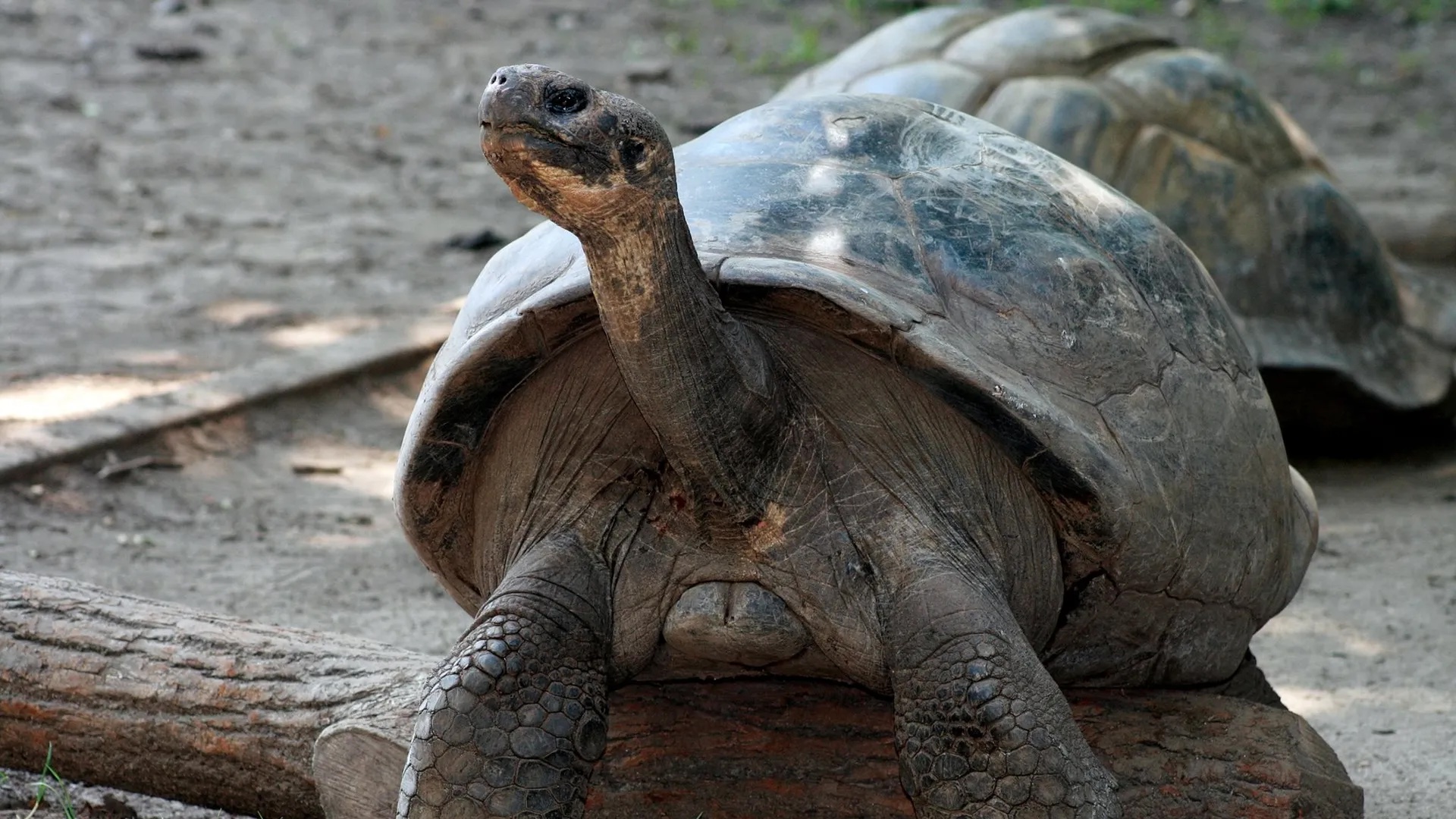
An endangered giant tortoise has become the oldest first-time mom of her species after having her first babies at around 100 years old.
There’s A New 'Most Canadian' Animal - And It's Probably Not What You Expect IFL Science - October 28, 2024
Beaver, moose, maybe a polar bear - all distinctly Canadian, right? They’re certainly icons of the North American nation, but when it comes to evolutionary distinctiveness, these animals are by no means the most Canadian. It turns out, by this metric, the spiny softshell turtle is in fact Canada’s most unique terrestrial animal.
Turtles Are Unexpected Time Capsules Of Earth's Nuclear Bomb History IFL Science - August 23 2023
When humans were busy pummeling the Earth with atomic bombs in the latter half of the 20th century, turtles and tortoises across the world were quietly (and very slowly) getting on with their lives. Unbeknownst to them, the legacy of the dreadful explosions was becoming deeply imprinted into their shells.
Baby Albino Turtle Born With Her Heart Beating Outside of Her Shell Defies the Odds + Video People - June 8, 2022
Hope has a condition so rare, there isn’t even a name for it. According to Caters New Agency, the albino pinkbelly sideneck turtle was born with her heart exposed. In humans, this condition is called ectopia cordis, but in veterinary medicine there is no name for the life-threatening genetic defect. Even with her heart beating outside of her shell, the baby turtle, named Hope, has defied the odds and survived. Hope lives with her owner Michael Aquilina in New Jersey. Aquilina, known as AquaMike on Instagram, was given the turtle by a friend who felt Aquilina had the passion and experience to give Hope the longest, happiest life possible.
Tiny white tortoise baby is the "first of its kind" Live Science - June 8, 2022
An extremely rare white tortoise baby has just been revealed to the world for the very first time. The tiny, red-eyed reptile has pigmentless skin and a pale shell, caused by a genetic disorder known as albinism. Zoo keepers say the odds of an albino tortoise are 1 in 100,000. The white tortoise is one of two Galápagos giant tortoises (Chelonoidis niger) that recently hatched at Tropiquarium, a zoo in Servion, Switzerland. The pair of eggs were laid by a 220-pound (100 kilograms) female on Feb. 11; the albino baby hatched on May 1 and its darker sibling emerged on May 5. The baby tortoises each weighed just 1.8 ounces (50 grams) at birth and were initially hand-reared by zookeepers in incubators, before rejoining their mother at the zoo on June 3, according to Reuters.
Giant tortoise thought extinct is found on Galapagos PhysOrg - February 21, 2019
The adult female tortoise was found on the island of Fernandina in the west of the Pacific archipelago, and is believed to be a Fernandina Giant Tortoise, also known as Chelonoidis phantasticus, a species last sighted in 1906. The tortoise is believed to be about 100 years old. It was taken by boat to the main Galapagos conservation center on Santa Cruz island.
8-Year-Old's Fossil Discovery Explains Why Turtles Have Shells Live Science - July 18, 2016
The proto-turtle Eunotosaurus burrows into the banks of a dried up pond to survive in the harsh, arid South African environment about 260 million years ago. In the background, a herd of Bradysaurus, a type of reptile, crowds around some muddy water. The turtle's shell may serve as a protective shield nowadays, but ancient turtles actually developed shells for an entirely different reason, a new study finds. Researchers looked at the remains of 47 ancient proto-turtles (Eunotosaurus africanus), ancient reptiles that sported partial shells. These animals had broadened ribs that likely helped them burrow underground, rather than serving as protective armor, the researchers said.
Researchers discover real reason why turtles have shells PhysOrg - July 15, 2016
The earliest beginnings of the turtle shell was not for protection but rather for digging underground to escape the harsh South African environment where these early proto turtles lived.
New Species of Giant Tortoise Found in the Galapagos Live Science - October 21, 2015
Paging Charles Darwin: The island of Santa Cruz within the Galapagos has not one but two distinct species of giant tortoise, a new genetic study finds. For years, researchers thought that the giant tortoises living on the western and eastern sides of Santa Cruz belonged to the same species. But the tortoises look slightly different, and so recently, scientists ran genetic tests on about 100 tortoises from both groups. The tests were definitive: The two tortoise populations, which live only about 6 miles (10 kilometers) apart on the opposite sides of the island, are actually extremely distant relatives.
'Lost' sea turtles don't go with the flow BBC - April 10, 2015
A tracking study has shown that young sea turtles make a concerted effort to swim in particular directions, instead of drifting with ocean currents. Baby turtles disappear at sea for up to a decade and it was once assumed that they spent these "lost years" drifting.
Turtles and dinosaurs: Scientists solve reptile mysteries with landmark study on the evolution of turtles Science Daily - November 24, 2014
A team of scientists has reconstructed a detailed 'tree of life' for turtles. Next generation sequencing technologies have generated unprecedented amounts of genetic information for a thrilling new look at turtles' evolutionary history. Scientists place turtles in the newly named group 'Archelosauria' with their closest relatives: birds, crocodiles, and dinosaurs.
Meet Jonathan, St Helena's 182-year-old giant tortoise BBC - March 13, 2014
Jonathan is a rare Seychelles Giant. His lawn-fellows hail from the Aldabra Atoll in the Indian Ocean. Aldabra Giants number about 100,000, but only one small breeding population of Seychelles tortoises exists.During the 17th Century ships could contain hundreds of easily-stacked tortoises, like a fast-food takeaway. In the Galapagos islands alone around 200,000 tortoises are thought to have been killed and eaten at this time. How did Jonathan avoid this fate?